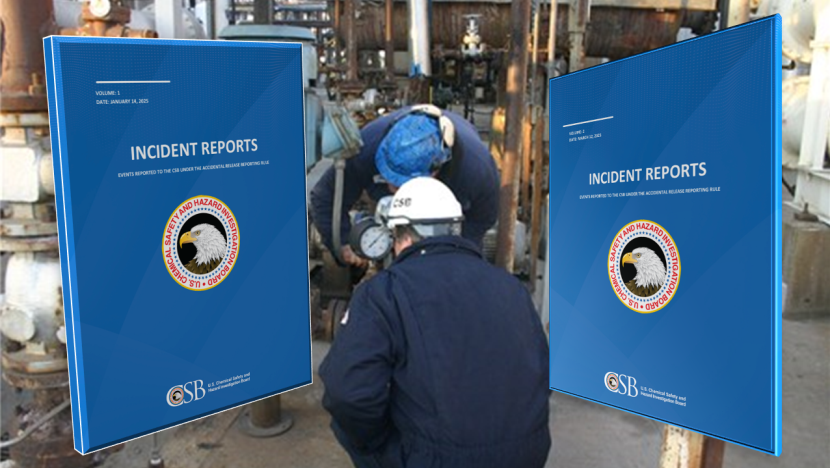“I am always ready to learn although I do not always like being taught.” — Winston Churchill
The Chemical Safety Board (CSB) describes its public safety mission as being to “drive chemical safety excellence through independent investigations to protect communities, workers, and the environment” with the vision of “a nation free from chemical disasters.” The CSB’s focus on independent investigations has resulted in 125 completed incident investigation reports since 1998. The CSB issued its most recent final report on June 3, 2025; it’s about the fatal molten salt eruption at the TS USA facility in Chattanooga, Tennessee.
The CSB is also well known for its videos about incidents. Their video archives include recordings of meetings and other news releases, but most of the videos in the archives are about specific chemical disasters and feature highly-regarded animations of the incidents.
Unfortunately, the CSB does not have the resources to directly investigate every incident involving hazardous chemicals. A review showed that on average, there are nine CSB‑reportable incidents per month, but the CSB has only had the resources to produce an average of 4 to 5 investigations per year. In an extraordinary push, the CSB issued 12 final investigation reports in 2023. Presently, however, there are only five current investigations.
Something new has been happening, though. The CSB has begun to compile the incident investigations conducted by others into one or two-page “incident reports”. It issued Volume 1, containing 26 reports, on January 14, 2025. It issued Volume 2, containing 25 reports, on March 12, 2025.
Volume 1 and Volume 2
The 51 incidents addressed in these two volumes were drawn from the incidents reported to the CSB since its reporting requirements went into effect in 2020. Both volumes cover the period since 2020 (although Volume 1 does not include any incidents from 2024, while Volume 2 includes five incidents from 2024), the same geography (seven Texas incidents in each volume, five Louisiana incidents in each volume, one each from California, Colorado, Illinois, and New Mexico, and then various other states, all seemingly chosen at random), have a similar distribution of fatal incidents, incidents resulting in serious injuries, and incidents resulting in significant property damage, and address a similar range of industries.
In other words, the two volumes are each representative of the entire set of CSB-reportable incidents and can be considered collectively.
The Industries
The 51 incidents in these volumes occurred all across the chemical enterprise:
- 16 incidents in refineries
- 12 incidents in specialty chemicals plants
- 6 incidents in chemical manufacturing complexes
- 4 incidents at crude oil production sites
- 4 incidents in food processing facilities
- 4 incidents in pulp and paper mills
In addition, there were incidents at a munitions plant, a gas pipeline, a distribution tank farm, a waste reclamation facility, and a specialty construction contractor that serves the chemical industry.
Less important than the types of facilities, though, are the types of incidents, at least as an opportunity to learn from these reports.
Types of Incidents
Process safety is about the prevention of fires, explosions, and toxic releases. All three, as well as other types of incidents, were well represented in the incident reports.
There were thirteen toxic gas releases, many of them fatal. The toxic gases consisted of hydrogen sulfide (5 incidents), anhydrous ammonia (2 incidents, both from refrigeration systems at food processing facilities), chlorine gas (2 incidents), and one each of hydrogen cyanide, methylene diphenyl diisocyanate, silicon tetrachloride, and titanium chloride.
There were five uncontrolled reactions.
There were even two incidents involving thermal exposure to hot water.
The balance were incidents involving combustion: fires and explosions. This included three incidents of vapor cloud fires or explosions. It also included seven incidents that the CSB described almost identically: “a hydrogen and hydrocarbon gas mixture was accidentally released into the firebox of a fired heater, where it ignited” resulting in a fire, explosion, or both.
Probable Causes
The CSB concludes each of these incident reports with a summary of the probable cause. The CSB always identifies a probable cause; each benefits from hindsight. Too often, the recommendation consists of stating the probable cause and then stating, in essence, “Don’t do that.” In some cases, the recommendations will only prevent an exact reoccurrence of the incident at the exact same facility, but not be generally applicable.
Some recommendations, however, are generally applicable, or at least applicable at more sites than the one where the incident occurred. These are the reasons we are interested in the incident reports.
Read the Reports
The only hazards that we can address are the hazards that we recognize. For those interested in process safety, time spent reading Volume 1 and Volume 2 of CSB’s compilation of incident reports will be time well spent. (And Volume 3 and Volume 4, when they come out.) Read them ready to learn. The recommendations may not be directly applicable, but a broader and deeper understanding of the hazards in the chemical enterprise will always be helpful.

Leave A Comment